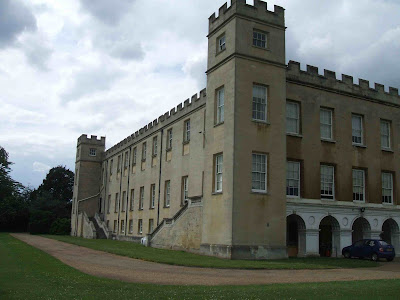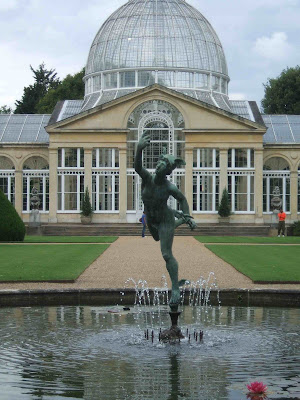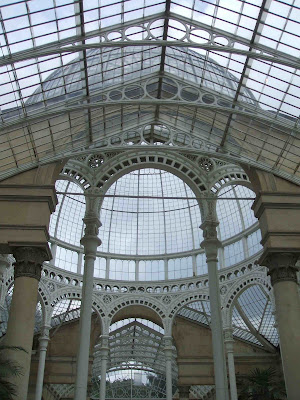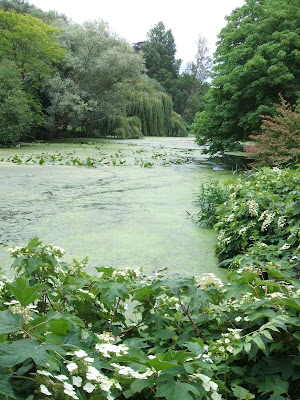Well, it’s been a month since I returned from my trip to England & France, so it’s about time I shared some pictures, right?
First, a picture of the front of Syon House.
Syon Park is located near London (and you can tell — it’s like a country house paradise, ruined by the constant noise of planes flying overhead), and bills itself “London home of the Duke of Northumberland.” (Ah, yes, that’s the sort of second home I could live with — I could even tolerate the planes.)
The next photo is of the back of Syon House. 
First came Syon Abbey. Then came Henry the Eighth. Syon Abbey refused to bow to Henry’s religious ideas, so soon, Syon Abbey was no more.
Which is really too bad, because Syon Abbey was apparently quite unusual… It was a Bridgettine Abbey, housing both men and women, and extremely wealthy. Recent architectural research argues that the Abbey Church was unique in England, and quite huge.
 Our next photo is, of course, a side view of the house!
Our next photo is, of course, a side view of the house!
In 1547, the Duke of Somerset (then Lord Protector to King Edward VI) took the estate, and began constructing Syon House in the Renaissance style. Of course, in true Renaissance fashion, Somerset eventually fell out of power, and was executed in 1552.
The house itself is a square house, built around an internal courtyard, giving the interior a lot of sunlight, and an airy, almost Mediterranean feel.
 Here we see the interior courtyard of the house.
Here we see the interior courtyard of the house.
In 1604, James I gave Syon to Henry Percy, the 9th Earl of Northumberland (and descendent of Shakespeare’s “Hotspur.”) Unfortunately, soon after this, his cousin took part in Guy Fawkes’s attempt to blow up Parliament, and the earl went to the Tower for fifteen years as a suspected conspirator.
 The next four photos show one of the most stunning features of Syon Park: the Great Conservatory.
The next four photos show one of the most stunning features of Syon Park: the Great Conservatory.
The Regency-era owners of Syon Park were Hugh, the 2nd Duke of Northumberland (who had the title from 1786 to 1817), and Hugh, the 3rd Duke of Northumberland (who was duke from 1817 to 1847).
The 2nd Duke was an army man, and fought in the Seven Years War and the American Revolution (where, among other things, he commanded the relief force at Lexington).
 The Great Conservatory was built between 1826 and 1827. The architect was Charles Fowler (who also designed the covered market at Covent Garden); the masonry, of Bath stone, was by Thomas Cundy; and the metalwork was by James Richards of Birmingham.
The Great Conservatory was built between 1826 and 1827. The architect was Charles Fowler (who also designed the covered market at Covent Garden); the masonry, of Bath stone, was by Thomas Cundy; and the metalwork was by James Richards of Birmingham.
The whole estate is really quite gorgeous. Though the outside of the house is plain and rather uninspiring (it’s no accident that brochures advertising the estate tend to show the conservatory rather than the house), the interiors are utterly fabulous. Adam did a lot of the interiors, including the famous double cube room. Inside photos are banned, so I have none, but if you want to see the interiors, you can see some here: http://www.syonpark.co.uk/

Todd and I did get rather lost walking from the train station to Syon Park — our directions were poor, and construction had made signs hard to see — so by the end of the day, our feet were killing us. But except for that, it was really a lovely day.
 Indeed, if you take one day trip from London to see a stately home, I think Syon would be my recommendation. I’ve seen most of the stately homes and villas near London, including Ham House, Marble Hill House, Chiswick, the Queen’s House in Greenwich, and Kenwood House, and I found Syon the most enjoyable.
Indeed, if you take one day trip from London to see a stately home, I think Syon would be my recommendation. I’ve seen most of the stately homes and villas near London, including Ham House, Marble Hill House, Chiswick, the Queen’s House in Greenwich, and Kenwood House, and I found Syon the most enjoyable.
The grounds are lovely too — but more on that later.
One particularly interesting thing we saw — some archeologists (and a television reality show about archeologists, or some such thing) are currently excavating the remains of Syon Abbey. (This is how they now realize just how huge the church at Syon Abbey was.)
As I mentioned, the grounds are lovely. We had neither the time nor the feet to do much walking around, but we did stroll a bit on this river path.
In an attempt to bring in more money, part of Syon Park has been made into a children’s playground, the fancy sort that one pays to visit. There is also a large commercial gardening center — which seemed quite popular.
Some guidebooks were rolling their eyes at all this sad commercialization, but it seems to me that children’s playgrounds and garden centres make more sense than some of the alternatives.
 Well, that was my trip to Syon! In the coming weeks, I shall have more photos for you all, and info about Regency-era Nice, among other things. (I have SO many photos! The blessing and the curse of having a digital camera.)
Well, that was my trip to Syon! In the coming weeks, I shall have more photos for you all, and info about Regency-era Nice, among other things. (I have SO many photos! The blessing and the curse of having a digital camera.)
And remember: in two weeks is our next cyber-meeting of The Jane Austen Movie Club! (I had erroneously said it was next week — sorry, I can’t read a calendar!!! Yes, Cara, it’s ALWAYS THE FIRST TUESDAY OF THE MONTH. Which means August 7.) This time we’ll be discussing the version of EMMA starring Gwyneth Paltrow and Jeremy Northam. So if you’ve ever seen it, please show up and share your opinions!
And if you’ve never had the chance, you still have a week to rent it…and see what you think about Ewan McGregor as Frank Churchill, Alan Cumming as Mr. Elton, and Toni Collette as Harriet Smith!
So…the questions for today are: which is your favorite photo? What was Henry the Eighth’s problem, anyway? What’s your favorite country house or villa? How would you like to have Syon as YOUR second home? And if you’ve ever been to Syon, what did you think?
Cara
Cara King, author of MY LADY GAMESTER, which has not a single country house any it, not even of any kind
 I read a sad little news story the other day in between the sad and huge news stories about flooding in England. English bumblebees are becoming rare.
I read a sad little news story the other day in between the sad and huge news stories about flooding in England. English bumblebees are becoming rare. Talking of which, here’s the business end of a bumblebee, and unlike honeybees, they can sting you more than once. So even though they look delightfully furry, it’s not a good idea to pet them.
Talking of which, here’s the business end of a bumblebee, and unlike honeybees, they can sting you more than once. So even though they look delightfully furry, it’s not a good idea to pet them. And it’s not only bumblebees that are endangered. In all, about fifty varieties of native bees in England have become extinct recently, and the reason is mostly the loss of hedgerows. A habitat for many species of plants, animals, and birds, these plantings were often centuries old, marking ancient land boundaries, and many have been destroyed by modern agribusiness. If you travel in the English countryside you can see the scars of hedgerows destroyed to make larger fields.
And it’s not only bumblebees that are endangered. In all, about fifty varieties of native bees in England have become extinct recently, and the reason is mostly the loss of hedgerows. A habitat for many species of plants, animals, and birds, these plantings were often centuries old, marking ancient land boundaries, and many have been destroyed by modern agribusiness. If you travel in the English countryside you can see the scars of hedgerows destroyed to make larger fields. But the good news is that the bumblebee has moved into the ‘burbs. It’s English gardens, crammed with flowering plants, that will help the bumblebee survive.
But the good news is that the bumblebee has moved into the ‘burbs. It’s English gardens, crammed with flowering plants, that will help the bumblebee survive.

















